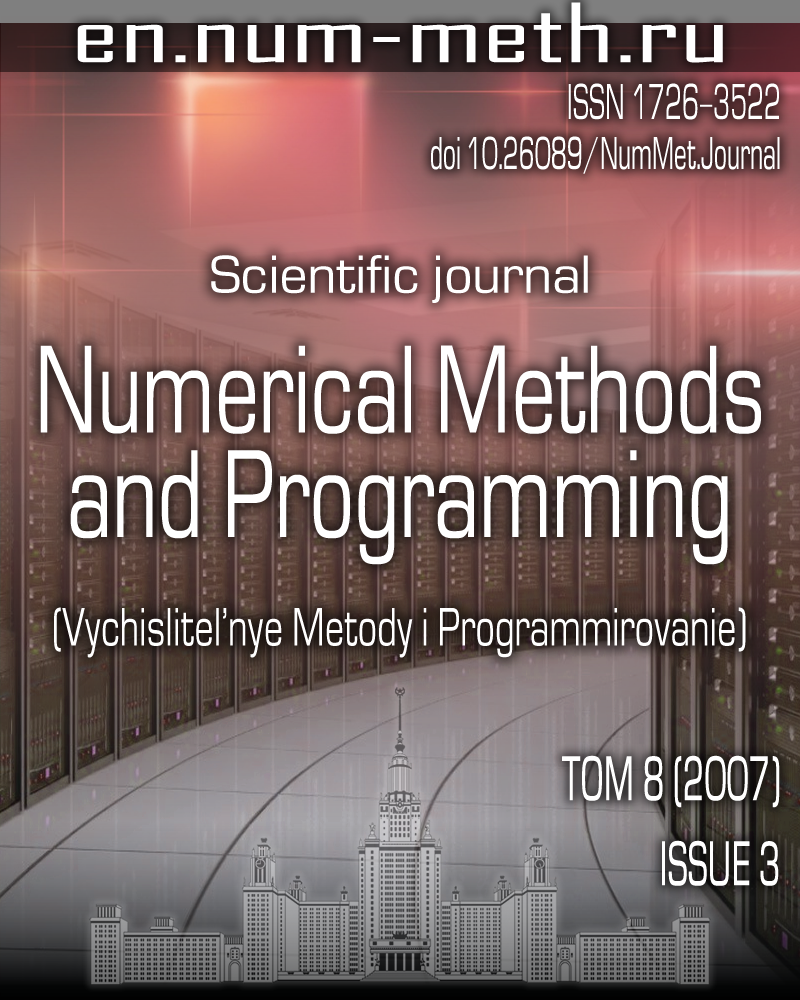A general approach to the implementation of methods for the implicit surface triangulation using space partitioning into cells
Keywords:
триангуляция
таблица случаев
разбиение пространства
марширующие кубы
марширующие призмы
пространственная триангуляция
Abstract
The most popular algorithms for constructing a triangulation of 3D-objects via space partitioning into cubic and tetrahedral cells are considered. А general approach to the triangulation on the basis of space partitioning into arbitrary cells is proposed. As examples, two new methods of triangulation are discussed. These methods use a space division into pyramids and prisms. Some peculiarities of computer implementation of these methods are analyzed. A qualitative comparative analysis of the resulting triangulations is given.
Published
2007-10-10
Issue
Section
Section 1. Numerical methods and applications
References
- Lorensen W.E., Cline H. Marching cubes: a high resolution 3d surface construction algorithm // ACM SIGGRAPH Computer Graphics. 1987. 21, N 4. 163-169.
- Gueziec A. Exploiting triangulated surface extraction using tetrahedral decomposition // IEEE Transactions on Visualization and Computer Graphics. 1995. 1, N 4. 328-342.
- Skala V. Precision of iso-surface extraction from volume data and visualization // Electronic Proc. of the Conf. on Scientific Computing 2000. 368-378 (http://www.emis.de/journals/AMUC/_contributed/algo2000/skala.pdf).
- Carneiro B.P., Silva C.T., Kaufman A.E. Tetra-Cubes: an algorithm to generate 3D isosurfaces based upon tetrahedra // Proc. of SIGGRAPH’96. Vol. 9. New Orleans, 1996. 205-210.
- Montani C., Scateni R., Scopigno R. Discretized marching cubes // Proc. of the Conf. on Visualization’94. Washington, DC, 1994. 281-287.
- Bourke P. Polygonising a scalar field. 1997 (http://astronomy.swin.edu.au/ pbourke/modelling/polygonise).
- Shephard M., Georges M. Automatic three-dimensional mesh generation by the finite octree technique // Int. J. for Numerical Methods in Engineering. 1991. 32. 709-749.
- Bloomenthal J. An implicit surface polygonizer // Graphics Gems IV. Boston: Academic Press, 1994. 324-349.
- Natarajan B.K. On generating topologically consistent isosurfaces from uniform samples // The Visual Computer: Int. J. of Computer Graphics. 1994. 11, N 1. 52-62.
- Семенихин А., Игнатенко А. Сравнительный анализ методов интерактивной триангуляции сеточных функций // Графика и мультимедиа. Вып. 6. 2004 (http://cgm.graphicon.ru/issue6/triangulation_comp/).
- Tavares G., Santos R., Lopes H., Lewiner T., Vieira A.W. Topological reconstruction of oil reservoirs from seismic surfaces // Proc. of the Conf. of the Int. Association for Mathematical Geology. Vol. 1. Portsmouth, 2003. 27-34.
- Hoppe H. Progressive meshes // Proc. of SIGGRAPH’96. New Orleans, 1996. 99-108.
- Evans F., Skiena S., Varshney A. Efficiently generating triangle strips for fast rendering. Technical Report. Department of Computer Science. State Univ. of New York at Stony Brook, USA, 1997.
- Schroeder W.J., Zarge J., Lorensen W.E. Decimation of triangle meshes // Computer Graphics. 1992. 26, N 2. 65-70.

